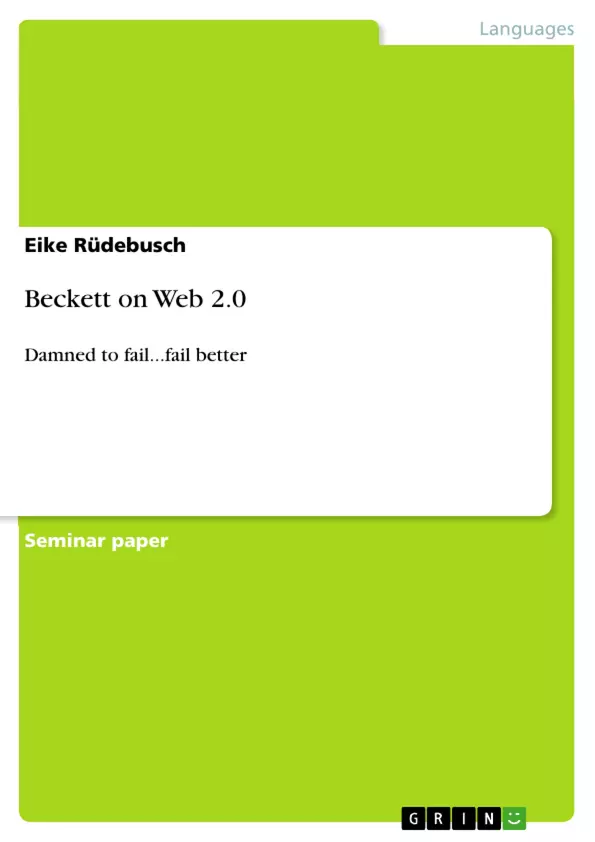Samuel Beckett certainly was one of the most important artists of the 20th century. His literature and drama changed the way people perceive arts and the tragic of human existence, further the way media displays them. Although Beckett was rigid regarding the realisation of his plays he was very open towards new media and techniques. He was up to date and wrote plays for the theatre, the radio and even for television. But he died before he could have used the possibilities the internet offers nowadays.
Nevertheless, Beckett is omnipresent in today‟s internet. You just have to type his name into Google and you will find 1.470.000 hits referring to him.1 Especially his presence on Youtube, a video community on the internet, is astonishing. There people have found many ways to adapt one or several of Beckett‟s works the way they wanted to. One could raise the question if this was what Beckett wanted, if this could have been avoided or if this was part of a logical consequence of the technological progress and the developments the internet has gone through within the last decade.
Having Paul Virilio‟s media theory in mind, the Aesthetics of Disappearance, in which he argues about the speed of information and the transformation of media, there is always a next step in terms of media, which in the end has led to the internet as it is today. Beckett always took that next step himself. Therefore, Beckett being part of the internet is the logical consequence of his work, of the way he used or was intrigued by different media, of the way he brought art to the latest medium – or is it not?
Throughout this paper I will argue that Beckett‟s work Play needed to be placed on the internet. I will try to prove that Play can make use of its full potential only within Web 2.0. I will start by reconstructing the media-history Play has gone through, from text to stage, from radio to television play. By doing that, I will point out that Beckett has always included another medium‟s potentials and techniques when adapting Play. Then, I will continue with Play on Web 2.0. I will describe what Web 2.0 actually means and where it came from, in order to later analyse Play on the internet, theoretically and aesthetically to finally conclude if Play really is best adapted on the internet.
Table of Contents
- Introduction
- Play in Various Media
- Play as Text / on Stage
- Play on Film
- Play on the Radio
- Play in Web 2.0
- What is Web 2.0?
- Why Play Fits into Web 2.0: Theory
- How Play Fits into Web 2.0: Text and Techniques
- Conclusion
Objectives and Key Themes
This term paper examines the potential of Samuel Beckett's play "Play" within the context of Web 2.0. The paper aims to demonstrate that "Play" can reach its full potential only within this digital environment. To achieve this, the paper analyzes the evolution of "Play" across various media, from its original textual form to its adaptations for stage, radio, and film. It explores the characteristics of Web 2.0 and its implications for the presentation and reception of dramatic works. The paper ultimately argues for the suitability of Web 2.0 as the ideal medium for "Play."- The evolution of Samuel Beckett's "Play" across various media
- The defining features of Web 2.0 and its influence on contemporary media
- The potential of "Play" to be fully realized within the context of Web 2.0
- The theoretical and aesthetic aspects of "Play" in the digital realm
- The role of technology and media in shaping artistic expression
Chapter Summaries
Introduction
The introduction provides an overview of Samuel Beckett's significance as a 20th-century artist, highlighting his impact on the perception of art and the tragic aspects of human existence. It emphasizes Beckett's openness to new media and his innovative use of different platforms, such as theatre, radio, and television. The introduction also explores Beckett's presence on the internet, particularly on YouTube, where his works have been adapted and reinterpreted by users. The paper aims to argue that Beckett's play "Play" is inherently suited for the internet, especially within the context of Web 2.0.Play in Various Media
This section examines the evolution of "Play" from its initial textual form to its adaptations for stage, film, and radio. It focuses on the structural elements of the play, including its tripartite division into chorus, narration, and meditation. The section also discusses the visual and auditory elements of the play, including the use of urns, spotlights, and sound effects.Play as Text/ on Stage
This section details the structure and staging of "Play" in its original theatrical form. It discusses the play's three characters, their roles, and their interactions, highlighting the use of spotlights to direct the characters' speech. The section describes the play's repetitive structure and its potential for multiple interpretations.Play on Film
This section focuses on the adaptation of "Play" for film, specifically the French version known as "Comédie." It explores the changes made for the film adaptation, such as the use of camera close-ups in place of spotlights and the use of sound editing techniques. The section emphasizes the continued exploration of visual and auditory elements in different media formats.Keywords
The key terms and concepts explored in this paper include Samuel Beckett, "Play," Web 2.0, media theory, aesthetics, digital art, technology, internet, YouTube, adaptation, performance, and artistic expression. The paper focuses on the evolution of "Play" across various media, the defining features of Web 2.0, and the theoretical and aesthetic aspects of digital art. The paper also touches upon the broader themes of media influence, artistic innovation, and the relationship between technology and creativity.- Arbeit zitieren
- Eike Rüdebusch (Autor:in), 2009, Beckett on Web 2.0, München, GRIN Verlag, https://www.hausarbeiten.de/document/150584


